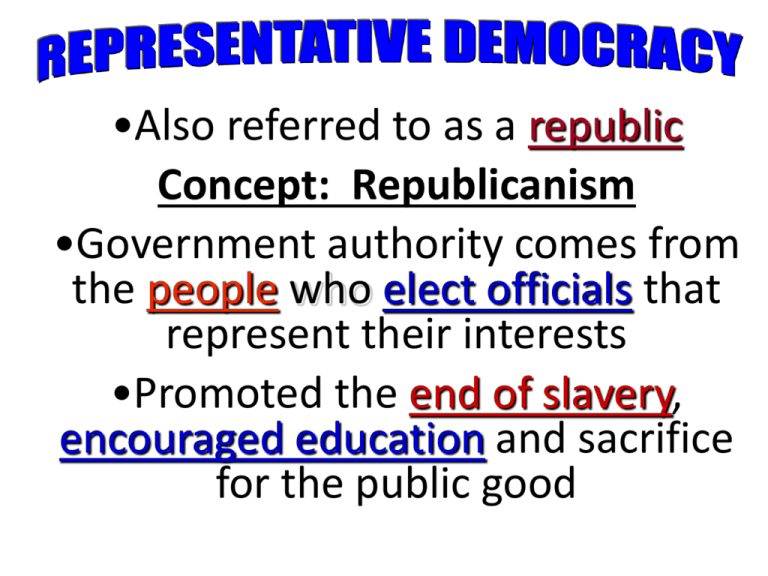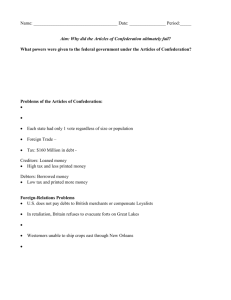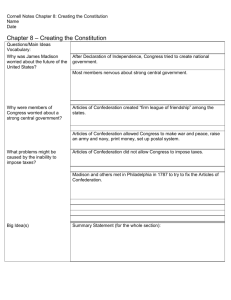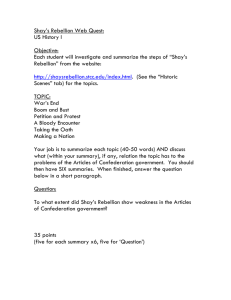State Constitutions
advertisement

•Also referred to as a republic
Concept: Republicanism
•Government authority comes from
the people who elect officials that
represent their interests
•Promoted the end of slavery,
encouraged education and sacrifice
for the public good
•13 colonies had a tradition of governing
themselves…..
•Elected their own representative law
making bodies
•Passed laws to keep peace within their
communities
• Colonies had a tradition of
representative democracy
•That’s why they fought the Revolution
StateFeatures
Constitutions
Common
of State
1. Popular sovereignty was the basis for every new
Constitutions
State constitution.
Popular
Sovereignty
2.
3.
Limited
Government
1.
2.
1.
Civil Rights
and Liberties
2.
Separation of Powers and
Checks and Balances
1.
2.
Government can exist and function only with the
consent of the governed.
People hold power and are sovereign.
Limited government was a major feature of each
State constitution.
Powers delegated to government were granted
reluctantly and included many restrictions.
In every state it was made clear that the sovereign
people held certain rights that the government must
respect at all times.
Seven of the new constitutions contained a bill of
rights, setting out the “unalienable rights”
State governments were purposely divided among
three branches: executive, legislative, and judicial.
Each branch was given powers with a system of
checks and balances.
We owed France, Spain and other countries
who helped us with the Revolutionary War.
Foreign Debt
$11,710,000
Individual states owed citizens who
loaned money to their state.
State Debt
$21,500,000
The new US Gov’t owed soldiers
for fighting in the war, plus debts
to the British and some Loyalists.
Federal Domestic Debt
$42,414,000
$80 Million
debt
The British were to remove their troops from US soil…..The National Government under the AOC was
powerless to force Great Britain to honor the Treaty of Paris, 1783
Jays
■Grid system was created
Jefferson…
■A structured and
■Allowed
Northwest
Territory
■Promoted
by Thomas
organized land policy
for a peaceful purchase of land
an orderly expansion westward..
■Confederation
Congress convinced states
who claimed land out west to cede their land
to the US Gov’t
■US Gov’t was to come up with a fair and
reasonable land policy…..Unlike the
Proclamation of 1763….
Northwest
Territory
Plot #16 was
set aside for
public
education
Public Land
sold for $1.00
to $2.00 an
acre in order
to pay debt
An addition to the Land
Ordinance of 1785
Northwest
Territory
Congress sold land in
large blocks: 40, 80, 160,
320 and 640 acres
$1 to $2 an acre to help
pay national debt
Encouraged settlers to form townships
New states formed would be = to original 13
Influx of settlers caused violence with Indians
Guaranteed settlers “unalienable rights”
Ohio
1ST STEP
2nd STEP
3rd STEP
WHEN PEOPLE FIRST
SETTLE IN THE AREA:
POPULATION REACHES
5,000 FREE ADULT MALES:
POPULATION REACHES
60,000 SETTLERS:
Congress appoints a
governor and three
judges to govern the
territory
Landowners elect a
congress to make laws
and raise taxes with
approval of governor.
One representative is
elected to the US
Congress who can debate
but not vote.
Territory becomes a state,
with its own government
and constitution. New
states were admitted with
same rights as the
original states. No more
than 5 states can be
carved out of this area.
The Northwest Ordinance encouraged ideals of the DOI and republicanism (representative democracy)
religious freedom, protection of liberty and property; It encouraged education, admitted new states and
discouraged slavery.
•Our first constitution (law of the land) and an
attempt to create a democratic government
based on the ideas of the Declaration of
Independence
•Written by the members of the 2nd Continental
Congress during the Revolutionary War
•took effect in March 1781… US legislature was
called the Confederation Congress
•Founding Fathers were determined not to have
a king…..
Confederation Government
government was a weak alliance of the 13 original states
each state was independent and conducted its own affairs
created a weak national gov’t which had few powers to
solve national problems
states held more power than the national gov’t
states would unite in times of crisis
like a “treaty of cooperation” between the states
Why this? Was a reaction to ‘unitary government’ where
the national gov’t has all the power
Government
Structure
Powers of
Congress
•Congress--1 house
•Declare war, make peace
(unicameral)
•Make & sign treaties
•Confederation Congress
•Build navy and army
•No executive branch or
•Settle disputes among
president…
states
•No judicial system…..
•Set up national monetary
•One vote per state regardless
system
of size
State
Responsibilities
•Obey Articles and Acts of
Congress
•provide funds and troops when
“requested” by Congress
•States regulated own trade and
taxed each other
•States had their own currency
Major Problem: Created a weak national gov’t that could not
tax, regulate trade, or enforce its laws because the states
held more power than the National Government.
Major Problem
Could not tax, regulate
trade or enforce its laws
because the states held
more power than the
National Government
Why?
Feared a government like
the British gov’t under
King George III
National Govt.
AOC/Congress given
20% of govt. powers
States were given 80% of
governmental
powers…States were
superior to the national
gov’t
EFFECTS of the Articles of
Confederation and the
Confederation Congress:
Could not deal effectively
with US problems
In early 1787 a group of small farmers protested against the
Massachusetts gov’t
Why? They were in debt, their homes were being repossessed
and they claimed they were unfairly taxed
They were led by Daniel Shays, a former army captain in the
Revolutionary War
Purpose of the rebellion: prevent foreclosures by keeping the
courts from sitting (meeting) until the next election
Shay’s Rebellion was put down by a private army paid for by
wealthy merchants from Boston
The Confederation Congress was unable to put down the rebellion
– could not raise a national guard or army
Shays
Daniel Shay
Shays
Outcomes
- The rebellion was
ended by a private
militia
- US Gov’t was too weak
to put down the
rebellion
- Americans feared too
weak a gov’t would lead
to anarchy
So, there were calls for a Constitutional Convention to change
the AOC and create a stronger national government
Why Create A New Constitution?
The AOC was unable to be used
decisively in a time of crisis. National gov’t
could not protect life, liberty and property
Provided all the evidence needed to
finally convene and revise the constitution
Why was Shay’s Rebellion such a
concern to our founding fathers?
The Elites Response to
Shay’s Rebellion:
“Respectable”
Americans were
shocked by the
violence. They feared
“mobocracy”.
Let us have
{ a Constitution }
by which our lives, liberties and
properties will be secured....
The Elites Response to
Shay’s Rebellion
The Annapolis Convention (1786)
George Washington hosted a conference at his home in Mt.
Vernon, VA (1785)
Representatives agreed that the problems were serious enough
to hold further discussions at a later meeting at Annapolis, MD,
at which all the states might be represented
Only 5 states sent delegates
Alexander Hamilton and James Madison persuaded the others
to call for a Constitutional Convention, to be held in Philadelphia
for the purpose of revising the Articles of Confederation
Social Change
• Abolition of Aristocratic Titles
– Social mobility
• Separation of Church and state
• The institution of slavery contradicted the idea that
“all men are created equal”
– Several northern states would abolish slavery
– Majority of southern slave-owners came to believe that
slave labor was essential to their economy
• Voting rights would expand
• Despite their contributions during the
Revolutionary War, women remained in a secondclass status







